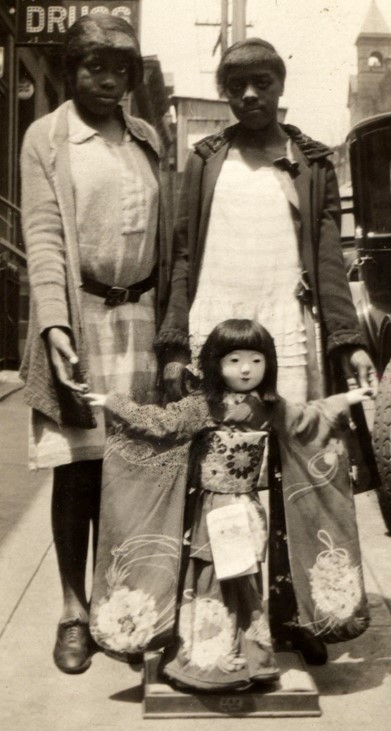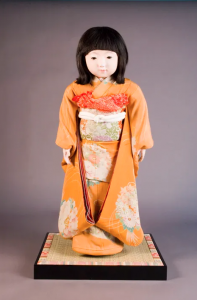

 In 1927, 14 years before the attack on Pearl Harbor would change the relationship between the two countries forever, Japan sent ambassadors to the United States in the form of lovely, elegantly clad, three-foot tall dolls, one of which visited Wheeling.
In 1927, 14 years before the attack on Pearl Harbor would change the relationship between the two countries forever, Japan sent ambassadors to the United States in the form of lovely, elegantly clad, three-foot tall dolls, one of which visited Wheeling.
The Power of Archives
One of the photographs chosen to illustrate a story I wrote for for Goldenseal Magazine, titled “Wheeling’s 20th Man: 250 Years of Race Relations in the Northernmost Southern City of the Southernmost Northern State” was this view of Chapline Street, looking north, dated 1928. It shows two girls, members of the segregated Blue Triangle Branch of the YWCA, standing in front of North Side Drugs on Chapline Street. James “Doc” White, a partner at the North Side Pharmacy, was a mentor, benefactor, and friend of the African American community in Wheeling. The bell tower of the old Lincoln School can be seen at right.
The article was published without those of us at the OCPL Archives knowing anything about the doll in the photograph, a ningyo, or Japanese Friendship doll, actually now known as Miss Tottori.
On September 24, 2019, OCPL Archives received an email through our “Ask an Archivist” online form from a gentleman named Alan Scott Pate, who wrote: “I am an author on the history of antique Japanese dolls. I recently published a book on the Friendship Doll exchange of 1927 (ART AS AMBASSADOR: THE JAPANESE FRIENDSHIP DOLLS OF 1927). A West Virginia publication recently included a photo from your archives depicting one of these dolls. Unfortunately the image was not clear enough for me to read the name plate on the doll's base nor see specific identifying details of her kimono. Is it possible to see a higher resolution image of this photograph for identification purposes? Also any additional information regarding the photo itself would be most appreciated.”
An article in the Saturday, May 19th, 1928 Wheeling Intelligencer provided context:
“Blue Triangle Branch of Y. W. C. A. to Meet Miss Mayagi [sic]. A valuable Japanese doll is on exhibit in the Main street window at Stifel’s. The doll comes as a messenger of good will from the children of Japan to the children of American and is an acknowledgment of American dolls sent to Japan last year by various clubs and organizations.
Lincoln grade school Girl Reserves will have a program at the Blue Triangle Center Saturday afternoon at 3 o'clock — 'A Welcome to Miss Mayagi.' This is the closing for this term of the educational club work of the Girl Reserves of the Young Women's Christian Association."
After sending the article to Mr. Pate, he replied: “As the dolls toured in 1928, there were many occasions for confusion as they travelled in large groups then gradually broke down into smaller and smaller sets. The stands with their names in English and Japanese were the only really way to identify the dolls. Passports and ship tickets were frequently stored together for safekeeping. Researchers like myself are trying to untangle their journeys and to help solve the identity mysteries. The doll in your photo listed as Miss Miyagi is the current Miss Tottori, located in Pierre, South Dakota. The doll originally sent to West Virginia, Miss Tochigi, is one of our missing dolls, so when any information about the Friendship Dolls in West Virginia appears on the radar there is much excitement! Thank you, again, for your kind assistance! Is it possible to receive permission to post your photo on my Facebook page where I chronicle the adventures, misadventures and discoveries related to the Friendship Dolls? I will of course give full credit to the Library……Most appreciatively; Alan Pate”
Pate’s Facebook post read: “The Lincoln School pictured in the back of the Friendship Doll photo (with bell tower) was a segregated school. Similarly the Blue Triangle was a segregated subdivision of the YWCA. "
Two mentions of the doll were found in the Blue Triangle collection at OCPL Archives.
In the April 20-May 18 report, under “Girl Reserves,” “The Grade School clubs have their closing tomorrow, the special feature being the visit of Miss Mayagi, the Japanese doll.” And in the May 19 – June 15 report, again under “Girls Reserves,” “The Grade School Clubs had affine visit with the Japanese doll, Miss Myagi [sic], The Beech Bottom and Triadelphia School clubs took part. 98 ice cream cones were served.”
 According to South Dakota's state website, sd.gov, a missionary to Japan named Dr. Sidney Gulick, formed the Committee on World Friendship among Children in 1926.
According to South Dakota's state website, sd.gov, a missionary to Japan named Dr. Sidney Gulick, formed the Committee on World Friendship among Children in 1926.
"Their first project was sending American dolls to Japan for 'Hina Matsuri,' the Japanese Doll Festival. Over 12,700 'blue-eyed' dolls from 48 states went overseas as a gift from the children of the United States. Japan returned the friendship gesture by sending 58 'Torei Ningyo' or Dolls of Gratitude to the United States in November 1927. Fifty-eight dolls were displayed in various shows before making their way to permanent homes in then-all 48 states and 10 cities. Some of the dolls were mislabeled or poorly identified between shows, and some accessories were mixed between dolls ... The Japanese attack on Pearl Harbor on Dec. 7, 1941, launched the United States and Japan into war and also ended the Friendship Doll program. The Japanese ordered the destruction of the American 'blue-eyed' dolls, but 335 survived. In the United States, the Japanese dolls went into storage and were lost. Only 45 of the original dolls have been located. Of the dolls that were found, historians and experts have determined that 25 dolls were misidentified. Only five dolls are still with their original accessories. Miss Tottori is one of the 25 misidentified Friendship Dolls. She was recently identified as Miss Miyagi by Japanese doll scholar Alan Scott Pate. Miss Miyagi was originally intended for Kansas but made its way to South Dakota. Historical misidentifications are considered permanent, so South Dakota’s Miss Tottori is now indeed Miss Tottori for all time."
But we still don't know exactly how Miss Tottori ended up in Wheeling.
As Mr. Pate concluded, "Aside from scattered newspaper references of African American communities contributing to the original Doll Messenger project of 1926, there is very little indication of the Friendship Dolls touring Black communities in 1928....a subject for deeper research!"
Sources
"Miss Tottori Doll on display at Cultural Heritage Center through December." https://news.sd.gov/news?id=news_kb_article_view&sys_id=ad9a1d881b1c69506e4aa97ae54bcbe8
Pate, A.S. Art As Ambassador: The Japanese Friendship Dolls of 1927. 2016.
Wheeling Intelligencer, May 19, 1928.
Wheeling Register, May 19, 1928.
© Copyright 2026 Ohio County Public Library. All Rights Reserved. Website design by TSG. Powered by SmartSite.biz.